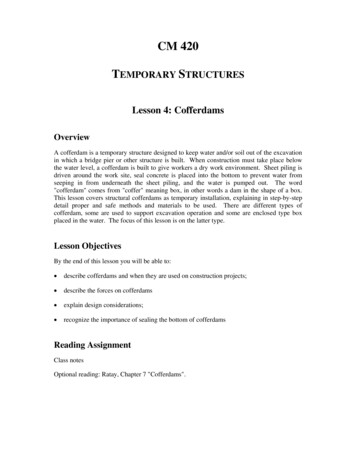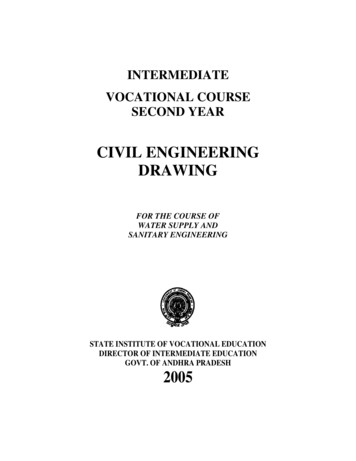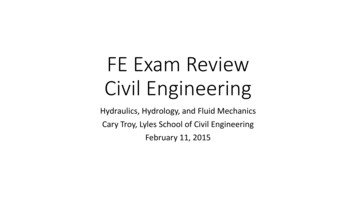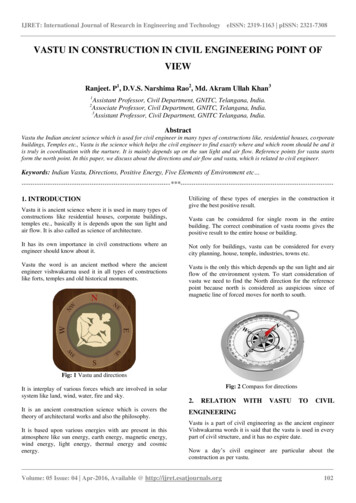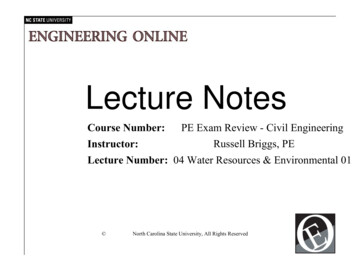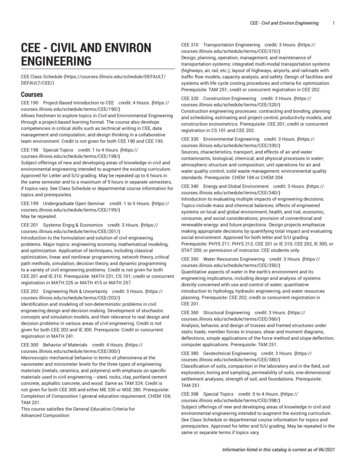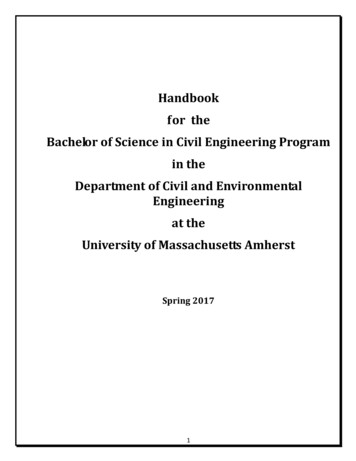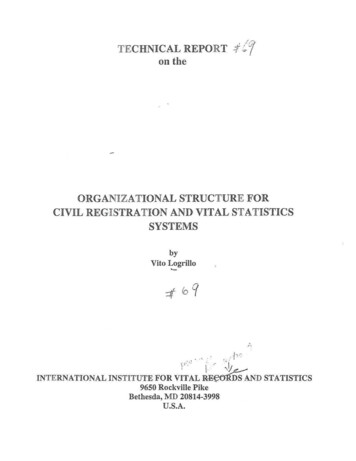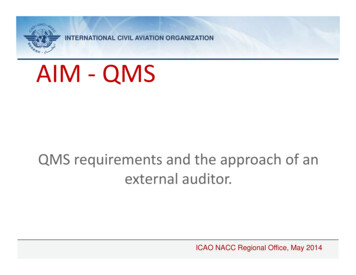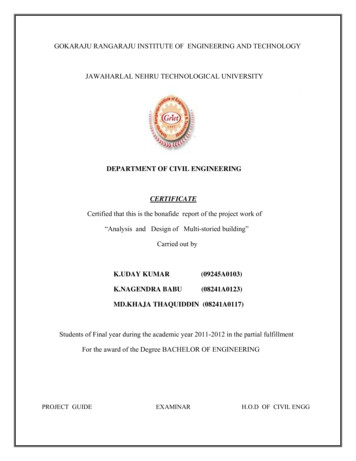
Transcription
GOKARAJU RANGARAJU INSTITUTE OF ENGINEERING AND TECHNOLOGYJAWAHARLAL NEHRU TECHNOLOGICAL UNIVERSITYDEPARTMENT OF CIVIL ENGINEERINGCERTIFICATECertified that this is the bonafide report of the project work of“Analysis and Design of Multi-storied building”Carried out byK.UDAY KUMAR(09245A0103)K.NAGENDRA BABU(08241A0123)MD.KHAJA THAQUIDDIN (08241A0117)Students of Final year during the academic year 2011-2012 in the partial fulfillmentFor the award of the Degree BACHELOR OF ENGINEERINGPROJECT GUIDEEXAMINARH.O.D OF CIVIL ENGG
Project ReportOnDESIGN AND ANALYSISOFMULTI-STORIED BUILDINGDEPARTMENT OF CIVIL ENGINEERING(2011-2012)Under the guidance ofV.GajendraM.E ( Transportation Engg)Associate professor(Civil Engineering Department)BYK.UDAY KUMAR(09245A0103)K.NAGENDRA BABU(08241A0123)MD.KHAJA THAQUIDDIN (08241A0117)Gokaraju Rangaraju Institute of Engineering & TechnologyJawaharlal Nehru Technological UniversityHyderabad
Project ReportOnDESIGN AND ANALYSISOFMULTI-STORIED BUILDINGA Dissertation submitted in partial fulfillment ofthe requirement for the award of degree ofBachelor of TechnologyInCIVIL ENGINEERINGByK.UDAY KUMAR(09245A0103)K.NAGENDRA BABU(08241A0123)MD.KHAJA THAQUIDDIN (08241A0117)DEPARTMENT OF CIVIL ENGINEERINGGOKARAJU RANGARAJU INSTITUTE OF ENGINEERING AND TECHNOLOGYJAWAHARLAL NEHRU TECHNOLOGICAL UNIVERSITYNIZAMPET ROAD,HYDERABAD-500090
CONTENTSS. No:1.2.TopicCHAPTER—1Introduction4Statement of the Project6CHAPTER—2Literature survey3.13CHAPTER—5Introduction to structural Analysis6.9CHAPTER—4Architectural layout drawing5.7CHAPTER—3Architecture4.Page no.CHAPTER—616
Staad pro7.19CHAPTER--7STRUCTURAL DESIGN29Design of Multistoried8.9.Residential Building30Foundation Design31Column Design31Beam Design32Slab Design32CHAPTER--8Loading system40Dead Load40Live Load41Imposed Loads41CHAPTER--9Analysis using Staad pro
And Input/Output details42Post processing of Structure78Post processing of membersColumns and Beams81Analysis of loading on Slab85Post processing of Beam,Column,Slab individuallyAnd NGS104
CHAPTER – 1INTRODUCTIONINTRODUCTIONAIMOur main aim to complete a Multi-storey building is to ensure that the structure is safeagainst all possible loading conditions and to full fill the function for which they have built.
Safety requirements must be met so that the structure is able to serve its purpose with themaintain cost.Detailed planning of the structure usually comes from several studies made by townplanners, investors, users, architects and other engineers. On that, a structural engineer has themain influence on the overall structural design and an architect is involved in aesthetic details.For the design of the structure, the dead load, live loads, seismic and wind load areconsidered. The analysis and design for the structure done by using a software package STAADPRO.In this project multistoried construction, we have adopted limit state method ofanalysis and design the structure. The design is in confirmation with IS456-2000.the analysis ofone frame is worked out manually and simultaneously it has been checked using STAAD PRO.Therefore an attempt has been made to present the multistoried building for residentialpurpose in the busy city of Hyderabad.The complex consisting of five storeys The structure isdesign based on the theory of LIMITSTATE METHOD which provides adequatestrength,serviceability and durability besides economySTATEMENT OF PROJECTSalient Features: The design data shall be as follows.1. Utility Of Buildings:Residential Building2. Area of each floor:160 sq.m3. No Of Storey:G 5
4. Shape of the Building:Rectangular5. No. Of Staircases:Six6. No. Of Lifts:One7. Types Of Walls:Brick WallGround Floor:9.0 MFloor-To-Floor Height:3.0 MHeight of Plinth:0.6 M above G.LDepth of Foundation:2 M below G.LConcrete Grade:M25All Steel Grades:HYSDREINFORCEMENT8. Geometric Details9. Material DetailsofGrade Fe415Bearing Capacity of Soil :10.FRAMED structure200 KN/M2Type Of Construction:R.C.C
CHAPTER – 2LITERATURE SURVEYLITERATURE SURVEYMajor advances in both design and new material assisted roman architecture. Designwas enhanced architectural developments in the construction of arches and roof domes. Archesimproved the efficiency and capability of bridges and aqueducts (fewer supports columns wereneeded to support the structure), while domed roofs not only permitted the building of largeropen areas undercover, but also lent the exterior an impressive.
The social unit that lives in a house is known as a household. Most commonly, a household isfamily unit of a same kind, though households can be other social groups, such as single person,or groups of unrelated individuals. Settled agrarian and industrial societies are composed ofhousehold units living permanently in housing of various types, according to a variety of farmsof lands tenure. English-speaking people generally call any building there routinely occupy“home”. Many people leave their houses during the day for work and recreation, and return tothem to sleep or for other activities.
CHAPTER – 3ARCHITECTUREARCHITECTUREArchitecture is the art and science of designing buildings and structures. A wider definitionwould include within its scope also the design of the total built environment, from the macrolevel of creating furniture. In the field of building architecture, the skill demanded of an architectrange from the more complex, such as for a hospital or stadium, to the apparently simpler, suchas planning residential houses. Many architectural works may be seen also as cultural andpolitical symbols, and /or work of art. The role of architect though changing, has been central tothe successful design and implementation of pleasing built environments in which people live.Scope: Architectural is an interdisciplinary field, drawing upon mathematics, science, arttechnology, social sciences, politics, history and philosophy. Vitrifies states: “architecture is ascience, arising out of many other sciences, and adorned with much and varied learning: by thehelp of which is judgment is formed of those works which are result of other arts”.
Most modern-day definition of “good buildings” recognize that because architecturedoes not exist in a vacuum, architectural form cannot be merely a completion of historicalprecedent, fictional necessities ; and socially aware concerns, but most also be a trance dentssynthesis of all of the former and a creation of worth in and of itself. As Nunziarodanini stated,“through its aesthetic dimension architecture goes beyond the functional aspects that it has incommon with other human sciences through its own particular way of expressing values,architecture can stimulate and influence social life without presuming that, in and of itself, it willpromote social development. To restrict the meaning of formalism to art for art’s sake is not onlyreactionary; it can be a purposeless quest for perfection or originality which degrades fro, into amere instrumentally”The term can be used to connect the implied architecture of abstract things such as music ormathematics the apparent architecture of natural things, such as geological formations or thestructure of natural things such as geological formations or the structure of natural things such asgeological formation or the structure of biological cells, or explicitly planned architectures ofhuman made things such as software, computers, enterprises, and databases, in addition tobuildings. In every usages an architecture may be seen as subjective mapping fro, a humanperspective (that of the user in the case of abstract or physical artifacts) to the elements orcomponents.Architecture is both the process and product of planning designing and constructingspace the reflects functional, social and aesthetic considerations. It requires the manipulation andcoordination of material. Technology, light and shadow.Architecture also encompassed thepragmatic aspects of realizing designed spaces, such as project planning, cost estimating andconstruction administration.Architectural works are often perceived as cultural and political symbols and as work ofart. Historical civilization is often identified with their surviving architectural achievements.Brunelleschi, in the building of the dome of Florence cathedral, not only transformed thecathedral and the city of Florence, but also the role and status of the architecture.With the consolidation of knowledge in scientific such as engineering and the rise ofnew building material and technology; the architect began to lose ground on the technical aspectof building. Therefore he concerned playing field that of aesthetics.There was the rise of the “gentlemen architect” who usually dealt with wealthy clientsand concentrated predominantly on visual qualities derived usually from historical prototypes. In
the 19th century, Cole des Beaux Arts in France,the training was toward producing quick sketchschemes involving beautiful drawings without much emphasis on context. The rise of professionof industrial design is usually placed here. Following this lead, the Bauhaus school, founded inGermany in 1919, consciously rejected history and looked at architecture as synthesis of art craftand technology.Architects such as Miens van Dee roe worked to reject the virtually all that had comebefore, trading handcrafted details and sentimental historic forms for a machine drivenarchitectural geometry made possible by the Industrial Revolution. They felt that architecturewas not a personal philosophical or aesthetic pursuit by individual rather it had to considereveryday needs of people and use technology to give a livable environment. That designMethodology Movement involving people such as chirrs Jones, Christopher Alexander startedfor more people-oriented designs.Extensive studies on areas such as behavioral, environmental, and social science weredone started informing the design process. as many other concerns began to be recognized,complexity of buildings began to increase in terms of aspect to be recognized, and complexity ofbuildings began to increase in terms of aspect such as services, architecture started becomingmore multi-disciplinary than ever. While the notion that structural and aesthetic considerationshould be entirely subject to functionality, which met with both popularity an skepticism, it hadthe effect of introducing the concept of “function” in the place of Vitruvius “utility”. “Function”came to be seen as encompassing all criteria of the use, perception and enjoyment of a building,not only practical but alsoaesthetic, psychological and cultural.“Now-a-day’s Architecture required a team of professionals in its making”.An architect is being one among the many and sometimes the leader. This I the state of theprofessional today, however, individually o still cherished and sought the design of buildingsseems as cultural symbols – the museum of fine arts centre has become a showcase for newexperiments in style, tomorrow may be something’s else.In the late 20th century, a new concept was added to those include in the compass of bothstructure and function, the consideration of sustainability. To satisfy the contemporary ethos abuilding should be a constructed in a materials, its impact upon the natural and built environmentof its surroundings area and the demands that it makes upon non-sustainable power sources forthe heating, cooling water and waste management and lighting. When modern architecture wasfirst practiced, it was an avant-garde movement with moral, philosophical, and aesthetic
underpinnings. Modernist architects sought to reduce buildings to a pure form, removinghistorical references in favors of purely fictional structures.The column arches and gargoyles of classical architecture were dubbed unnecessary.Buildings that flaunted their construction exposing steel beams and concrete surfaces instead ofhiding them behind traditional forms were beams and concrete surfaces instead of hiding thembehind traditional forms were seen as beautiful in their own right. Architecture first evolved outof the dynamics between needs (shelter, security, worship etc.,) and means (available buildingmaterial and attendant skills). As human culture evolved and knowledge began to be formalizedthrough oral tradition and practices, architectures became a craft.CHAPTER – 4ARCHITECTURAL LAYOUTDRAWINGS
vfdgfdgfgELEVATIONELEVATIONFig 01.
PLANFig 02.sTRUCTURAL ANALYSIS
The procedure of structural analysis is simple in concept but complex. In detail. Itinvolves the analysis of a proposed structure to show that its resistance or strength will meet orexceed a reasonable expectation. This expectation isusually expressed by a specified load orthe demand and an acceptable margined of safety that constitutes a performance goal for astructure. The performance goals structural design is multifaceted. Foremost, a structure mustperform its intended function safely over its useful life.The concept of useful life implies consideration of durability and established the basis forconsidering the cumulative exposure to time varying risks (i.e. corrosive environments, thatperformance is inextricably linked to cost, owners, builders, and designer must considerseconomic limit to the primary goal of safety and durability.In the view of the above discussion, structural designer may appear to have little controlover the fundamental goals of structural design except to comply with or exceed the minimumlimits established by law. While this is generally true, a designer can still do much to optimizethe design through alternative means and methods that can for more efficient analysis techniques,creative design detailing, and the use of innovative construction materials and methods. Insummary the goal of structural design are defined by law and reflect the collective i
M.E ( Transportation Engg) Associate professor (Civil Engineering Department) BY K.UDAY KUMAR (09245A0103) K.NAGENDRA BABU (08241A0123) MD.KHAJA THAQUIDDIN (08241A0117) Gokaraju Rangaraju Institute of Engineering & Technology Jawaharlal Nehru Technological University Hyderabad . Project Report On DESIGN AND ANALYSIS OF MULTI-STORIED BUILDING A Dissertation


